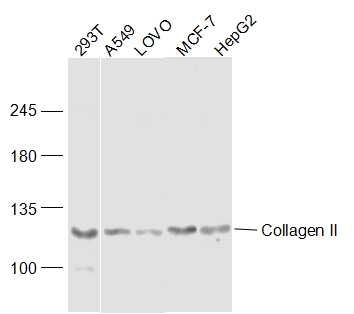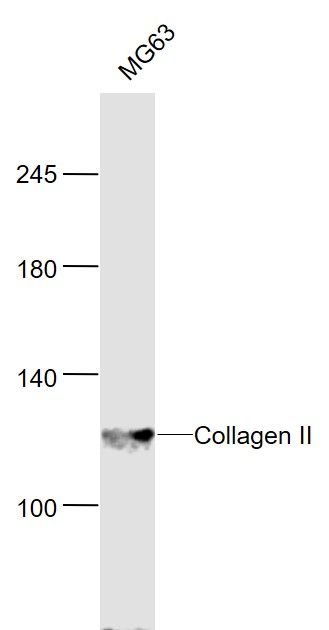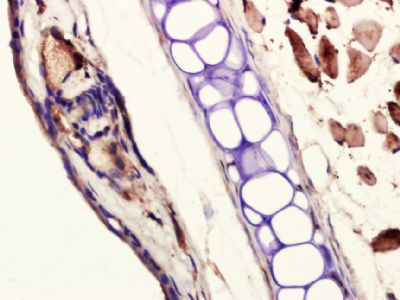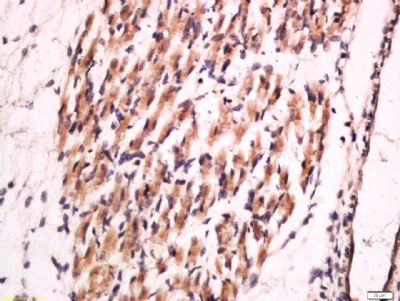[IF=0] Ren Y et al. A collagen mimetic peptide-modified hyaluronic acid hydrogel system with enzymatically mediated degradation for mesenchymal stem cell differentiation. Materials Science and Engineering: C,2019, 110276. ICC ; Rabbit.
[IF=5.191] Wenhui Hu. et al. Farnesoid X receptor agonist attenuates subchondral bone osteoclast fusion and osteochondral pathologies of osteoarthritis via suppressing JNK1/2/NFATc1 pathway. Faseb J. 2022 Apr;36(4):e22243 IHC ; Mouse.
[IF=1.785] Chao Ye. et al. Naringin and bone marrow mesenchymal stem cells repair articular cartilage defects in rabbit knees through the transforming growth factor‑β superfamily signaling pathway. Exp Ther Med. 2020 Nov;20(5):1-1 IHC ; Rabbit.
[IF=8.724] Yang Ling. et al. Three-dimensional (3D) hydrogel serves as a platform to identify potential markers of chondrocyte dedifferentiation by combining RNA sequencing. Bioact Mater. 2021 Sep;6:2914 IF ; Pig.
[IF=5.116] Haoqing Yanget al. DLX5 and HOXC8 enhance the chondrogenic differentiation potential of stem cells from apical papilla via LINC01013. Stem Cell Res Ther
. 2020 Jul 6;11(1):271. IHC ; rabbit.
[IF=4.717] Liu C et al. Kartogenin enhances the therapeutic effect of bone marrow mesenchymal stem cells derived exosomes in cartilage repair. Nanomedicine (Lond). 2019 Dec 2. IHSLCP ; Rat.
[IF=4.263] Wu X et al.The role of Ca 2+ in acid-sensing ion channel 1a-mediated chondrocyte pyroptosis in rat adjuvant arthritis.(2018) Lab Invest. WB ; Rat.
[IF=0.971] Yang et al. Isolation and biological characterization of tendon-derived stem cells from fetal bovine. (2016) In.Vitro.Cell.Dev.Biol.Ani. 52:846-56 IF(ICC) ; Rat.
[IF=0] Xu et al. Treatment with SiMiaoFang, an anti-arthritis chinese herbal formula, inhibits cartilage matrix degradation in osteoarthritis rat model. (2013) Rejuvenation.Re. 16:364-76 IHSLCP ; Rat.
[IF=3.76] Shi, Yang, et al. "Hypoxia combined with spheroid culture improves cartilage specific function in chondrocytes." Integrative Biology 7.3 (2015): 289-297. Rat.
[IF=9.933] Qi Feng. et al. Dynamic nanocomposite microgel assembly with microporosity, injectability, tissue-adhesion and sustained drug release promotes articular cartilage repair and regeneration. 2021 Dec 07 IHC ; Mouse.
[IF=5.026] Ting-ting Yu. et al. Deletion at an 1q24 locus reveals a critical role of long noncoding RNA DNM3OS in skeletal development. Cell Biosci. 2021 Dec;11(1):1-15 IF ; Mouse.
[IF=4.545] Kai Zhao. et al. Rhizoma drynariae total flavonoids inhibit the inflammatory response and matrix degeneration via MAPK pathway in a rat degenerative cervical intervertebral disc model. Biomed Pharmacother. 2021 Jun;138:111466 IF ; Rat.
[IF=1.98] Luo Wenbin. et al. Printability Optimization of Gelatin-Alginate Bioinks by Cellulose Nanofiber Modification for Potential Meniscus Bioprinting. J Nanomater. 2020;2020:3863428 IHC ; Bovine.
[IF=1.879] Guangdi Li. et al. The relationship between abnormal Core binding factor-β expression in human cartilage and osteoarthritis. Bmc Musculoskel Dis. 2021 Dec;22(1):1-13 IHC ; Human.
[IF=3.383] Guangduo Zhu et al. Exosomal miR-532–5p from bone marrow mesenchymal stem cells reduce intervertebral disc degeneration by targeting RASSF5. Exp Cell Res. 2020 Aug 15;393(2):112109. WB ; Rat.
[IF=2.985] He D et al. Propionibacterium acnes induces intervertebral disc degeneration by promoting nucleus pulposus cell pyroptosis via NLRP3-dependent pathway. Biochem Biophys Res Commun
. 2020 Jun 4;526(3):772-779. IHC ; rabbit.
[IF=5.039] Luo P et al. IL‐37b alleviates inflammation in the temporomandibular joint cartilage via IL‐1R8 pathway. Cell Prolif. 2019 Sep 27:e12692. IHSLCP ; Rat.
[IF=2.784] Ma C et al.Isolation and biological characteristic evaluation of a novel type of cartilage stem/progenitor cell derived from Small‑tailed Han sheep embryos.Int J Mol Med. 2018 Jul;42(1):525-533. ICF ; Sheep.
[IF=2.348] Ren et al. Treatment of rabbit intervertebral disc degeneration with co-transfection by adeno-associated virus-mediated SOX9 and osteogenic protein-1 double genes in vivo. (2013) Int.J.Mol.Me. 32:1063-8 WB ; Rabbit.



